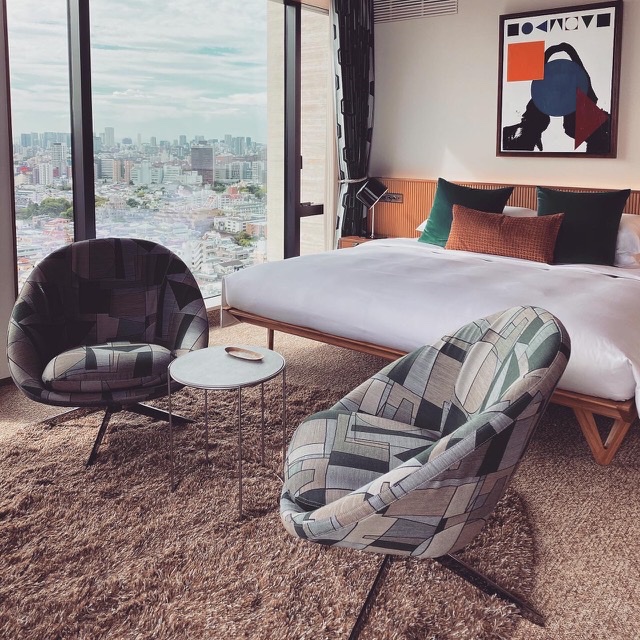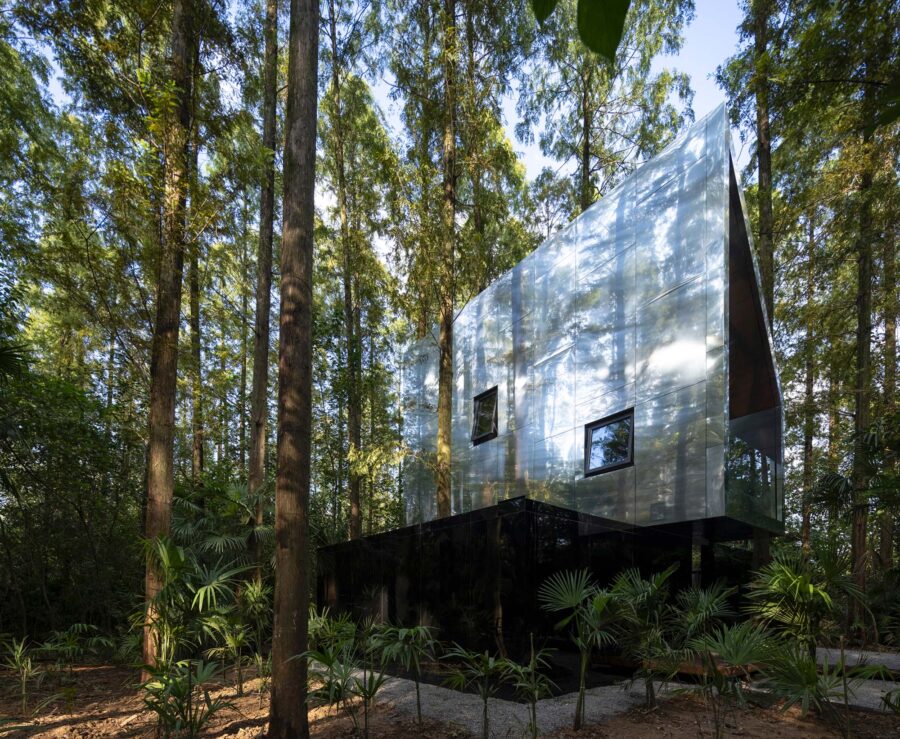
CULTURE


©︎ CreatAR Images
〈Cloudscape of Haikou〉は、中国南端に位置する歴史ある港湾都市・海口市の活性化のためにつくられた、図書館や読書スペース、カフェなどを有する有機的な建築です。
未知なる世界への冒険である読書と同様に、この洞窟のような複雑な形状の〈Cloudscape of Haikou〉を訪れるという体験も、日常から緩やかに離れる瞬間としてデザインされています。
未来的で有機的なさまざまな建築を手がける中国の設計事務所MADアーキテクツ(MAD Architects)が設計しました。
(以下、MAD Architectsから提供されたプレスキットのテキストの抄訳)

©︎ CreatAR Images

©︎ CreatAR Images
マー・ヤンソン(Ma Yansong)率いるMADアーキテクツが中国の南端、海口市に設計した〈Cloudscape of Haikou〉は海口市民や観光客のためのユニークな都市型公共・文化空間であり、コンクリートでつくられた流れるようなフォルムは、ロンドンタイムズ紙で「2021年に最も期待される建築プロジェクト」の1つに選ばれたプロジェクトである。

©︎ Aogvision

©︎ CreatAR Images
中国の南端に位置する港湾都市である海口市は、かつて海上シルクロードの重要な中継地であった。海南国際観光島や海南自由貿易区の設立により、現代では海口の重要性は徐々に復活している。
一方で海口市政府は、都市、人、建築のつながりを強め、市の文化的重要性を高めるため、公共空間の整備に力を入れている。〈Cloudscape of Haikou〉は、このような取り組みの集大成の1つである。

©︎ CreatAR Images

©︎ ArchExist
歴史ある港湾都市を彩るパビリオン群
〈Cloudscape of Haikou〉は、海口旅遊文化投資控股集団(Haikou Tourism and Culture Investment Holding Group)が歴史ある港町の活性化のために、海岸線の公共空間を改善する目的で委託した16の海岸パビリオンのうちの最初のものである。
「Haikou, Pavilions by the Seaside」と呼ばれる一連のプロジェクトは、国際的な建築家、アーティスト、学際的な専門家のチームを招き、16のランドマークとなる公共施設を建設する計画である。

©︎ CreatAR Images

©︎ ArchExist
このパビリオン群の中において〈Cloudscape of Haikou〉は、書店や市民のための施設を含む建築となっている。海口湾に面したセンチュリーパーク内に位置している。
パビリオンの南側には、1万冊の本を収蔵できる図書館と読書スペース、多機能なオーディオビジュアルエリアがあり、無料で一般公開されている。北側には、カフェ、公衆トイレ、バリアフリートイレ、シャワー、授乳室、休憩所、ルーフガーデンなどがある。

©︎ CreatAR Images

©︎ CreatAR Images
有機的な建築がつくる非現実な体験
新しい本を読み始めるということは、読者にとって超現実や未知の世界への冒険であり、日常の現実から緩やかに離れる瞬間である。そして、〈Cloudscape of Haikou〉を訪れるという体験も同様である。
この建築は、人々が見慣れた都市の現実から離れ、時間と空間を超えた新しい旅を始めることを可能にする。洞窟のような複雑な形状は、空間を一層ずつ分解し、読者に想像力が宿る無重力の場を提供する。

©︎ CreatAR Images

©︎ CreatAR Images
陸と海の間にひっそりと佇むこの建物は、非常に彫刻的である。また、パビリオンの自由で有機的なフォルムは、壁、床、天井が予測不可能な形で融合し、屋内と屋外の境界があいまいでユニークな内部空間をつくり出している。
円形の開口部は、野生動物の巣穴を連想させ、建築と自然の境界をあいまいにしている。また、開口部の大きさを変えることで、内部に自然光を取り込むとともに、年間を通して温暖な気候の海口において、自然換気での建物の冷却を可能にしている。
この穴から空や海を眺めると、まるで時空を超えて見慣れた世界を眺めているかのように感じられるのである。

©︎ ArchExist
1階と2階をつなぐ海に面した階段状の読書スペースは、読書だけでなく、文化活動や交流の場にもなっている。メインの読書スペースから切り離された子ども用の読書スペースには天窓や穴、すき間が配されており、子どもたちの探究心を刺激する。
〈Cloudscape of Haikou〉には半屋外の空間がいくつか設けられており、読書をしたり海を眺めたりするのに最適な空間となっている。また、建物外周部に配された外廊下は快適な温度を実現するために庇で覆われており、暑い気候にも対応できる省エネルギーな構造となっている。

©︎ ArchExist
MADアーキテクツはこのパビリオンを通じて「アンチ・マテリアル」アプローチを提唱している。これは構造や施工における過度な表現を避けることで、素材のもつポテンシャルを開放し、その素材特性が空間の主体となるというものである。
ここでは、コンクリートはもともと液体のような素材であり、流動的で柔らかく可変的という特徴に目を向けている。

©︎ ArchExist

©︎ ArchExist
建物の内外は打ち放しコンクリートで打設されており、1つのまとまりとなって流れるようなフォルムをつくり出している。屋根と床には二重構造のワッフルスラブを採用することにより、建物のおおらかなスケール感とキャンチレバーを支えている。
〈Cloudscape of Haikou〉のデザインは、デジタルモデルを用いて行われた。機械、電気、配管といった要素をコンクリートに設けた空洞内に隠すことで、外観への表出を最小限に抑え、視覚的な一貫性を持たせている。パビリオンの滑らかで有機的な形状は、この建築、構造、機械、電気設計の統合により実現されたのである。

©︎ ArchExist

©︎ ArchExist
MADアーキテクツの創設者であるマー・ヤンソンは次のように語る。
「精神性は建築の核となる価値観である。そしてこの精神性は、都市に人間らしさを与えるために重要なものである。私たちはこの建物を、人々が日常生活の一部にしたくなるような都市空間となることを願っている。建築、芸術、人間性、自然がここで出会い、さまざまな美が生活にもたらす影響を知り、それを理解するための想像の旅が始まるのである。」

©︎ ArchExist

©︎ ArchExist

©︎ ArchExist

©︎ ArchExist

©︎ ArchExist




以下、MAD Architectsのリリース(英文)です。
MAD-designed the Cloudscape of Haikou Completes and Opens
MAD Architects, led by Ma Yansong, has announced the opening of the Cloudscape of Haikou on the southern tip of China. A unique urban public and cultural space for citizens and visitors to Haikou, this flowing, sculptural concrete form was named as one of the “most anticipated architecture projects of 2021” by The Times of London.
A prominent port city on the southern tip of China, Haikou was once an important stop on the Maritime Silk Road. With the establishment of the Hainan International Tourism Island and Hainan Free Trade Zone, Haikou’s influence has seen a gradual resurgence in modern times. Meanwhile, Haikou’s government is also enriching the city’s cultural importance, through enhancing the social attributes of the city’s public spaces, and strengthening the connection between the city, humanities, and architecture. The Cloudscape of Haikou is one such culmination of this effort.
The Cloudscape of Haikou is the first of sixteen coastal pavilions commissioned by the Haikou Tourism and Culture Investment Holding Group to rejuvenate the historic port city, with the aim of improving public space along the coastline. Known as “Haikou, Pavilions by the Seaside,” the initiative invited teams of internationally recognized architects, artists, and interdisciplinary professionals to create sixteen landmark public stations.
MAD joins this collection of pavilions with a building containing a bookstore and citizen amenities. Situated in Century Park on the shore of Haikou Bay, the project covers an area of 4,397 square meters, with a construction area of 1,380 square meters. To the south side of the pavilion is a library and reading space capable of holding 10,000 books, as well as a multi-functional audio-visual area: free and open for public use. Meanwhile, the building’s northern area features a café, public restrooms, barrier-free restrooms, showers, a nursery room, a public rest area, and a roof garden.
Beginning a new book is often a moment that readers cherish: a venture into the surreal or unknown, and a gentle removal from everyday reality. The visiting experience of the Cloudscape is similar. The architecture enables people to approach the building removed from our familiar urban reality, and begin a new journey transcending time and space. The complexity of the cave-shaped form deconstructs the space layer by layer, offering readers a weightless field to be inhabited by their imagination.
The building, quietly located between land and sea, is highly sculptural. The pavilion’s free and organic forms also allow for the creation of unique interior spaces, where walls, floors and ceilings merge in unpredictable ways, and the boundaries between the indoors and outdoors are blurred.
The circular openings of the building are reminiscent of holes forged by wildlife or seas, blurring the boundary between architecture and nature. The varying sizes of the openings allow natural light into the interior, and create a natural ventilation effect to cool the building in Haikou’s year-round warm climate. Through the holes, people observe the sky and sea, as if looking at a familiar world through the passage of time and space. This layering of atmospheres, and collision between people and space, creates a sense of living ritual.
The cascading reading area facing the sea, which connects the first and second floors, is not exclusively for reading, but also a venue for cultural exchange activities. The children’s reading area is isolated from the main reading space, where skylights, holes, and niches stimulate the children’s desire to explore.
The structural form creates several semi-outdoor spaces and platforms, which also serve as excellent spaces for people to read and gaze at the sea. In response to the local hot climate, the gray space of the building’s outer corridor is cantilevered to achieve comfortable temperatures, culminating in a sustainable, energy-saving structure.
Through their pavilion, MAD champions an “anti-material” approach, avoiding the intentional expression of structure and construction, thus dissolving the inherent everyday perception of the material, and allowing the spatial feeling itself to become the main subject. Here, concrete is a liquid material, characterized by its flowing, soft, and variable structural form.
The interior and exterior of the building are cast in fair-faced concrete to create a single cohesive, flowing form. The roof and floor feature double-layered waffle slabs that support the building’s scale and large cantilever. The design development was conducted and tested using digital models. It was possible to hide all mechanical, electrical, and plumbing elements within the concrete cavity to minimize their appearance and create visual consistency. The smooth, organic aura of the pavilion is only made possible by this key integration of architecture, structure, and mechanical and electrical design.
Ma Yansong said, “Spirituality is the core value of architecture. It contributes to the humanistic atmosphere of a city. We want this building to be an urban space that people would like to make part of their daily lives. Architecture, art, humanity, and nature meet here, opening up a journey of visitors’ imaginations to explore and appreciate the meaning that different beauties bring to their lives.”
The Cloudscape of Haikou
Haikou, Hainan Province, China
2019-2021Site area: 4,397 sqm
Building area: 1,380 sqmPrincipal Partners in Charge: Ma Yansong, Dang Qun, Yosuke Hayano
Associate in Charge: Fu Changrui
Design Team: Qiang Siyang, Shang Li, Sun Feifei, Dayie Wu, Alan Rodríguez Carrillo, Xie Qilin, Beatrice BavusoClient: Haikou Tourism & Culture Investment Holding Group
Executive Architect: East China Architectural Design and Research Institute
Façade Consultant: RFR Shanghai
Lighting Consultant: Beijing Ning Field Lighting Design Corp., Ltd.
Signage Design: 2×4 Beijing
Interior Design: Beijing Ling & BuYao Interior design
Construction Contractor: Yihuida Shimizu Concrete
「The Cloudscape of Haikou」MAD Architects 公式サイト
http://www.i-mad.com/work/the-cloudscape-of-haikou/?cid=4









